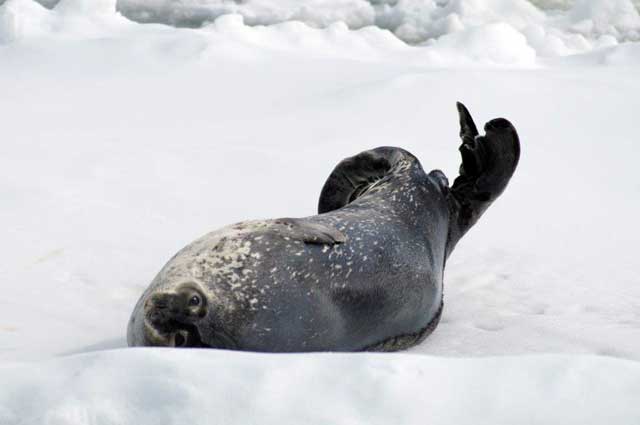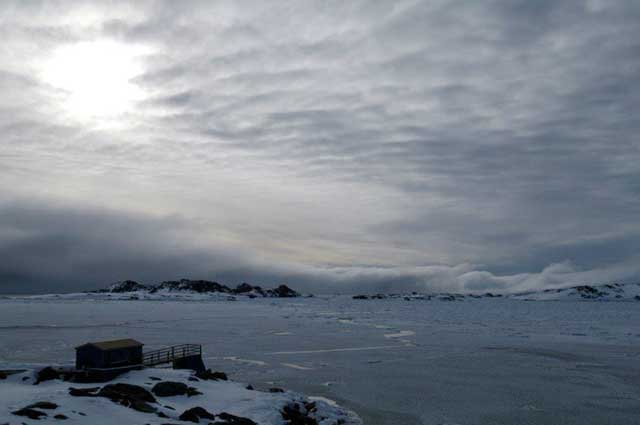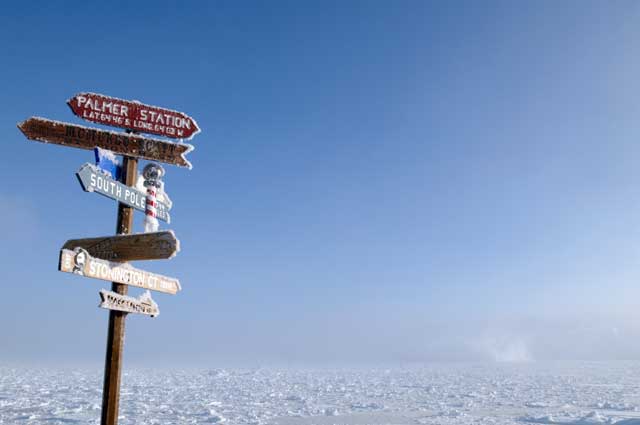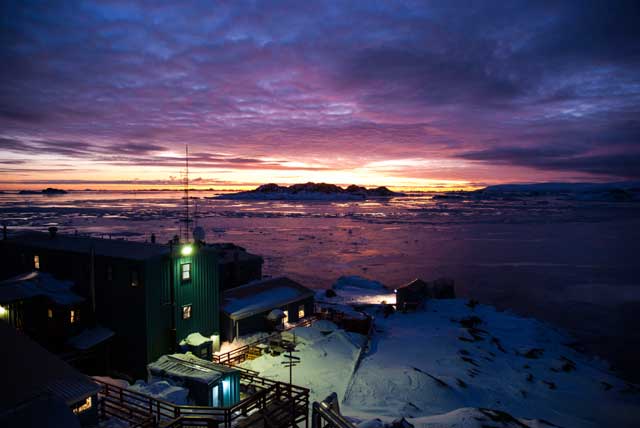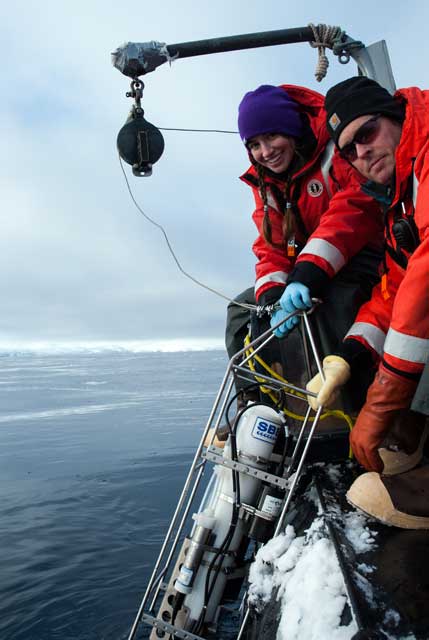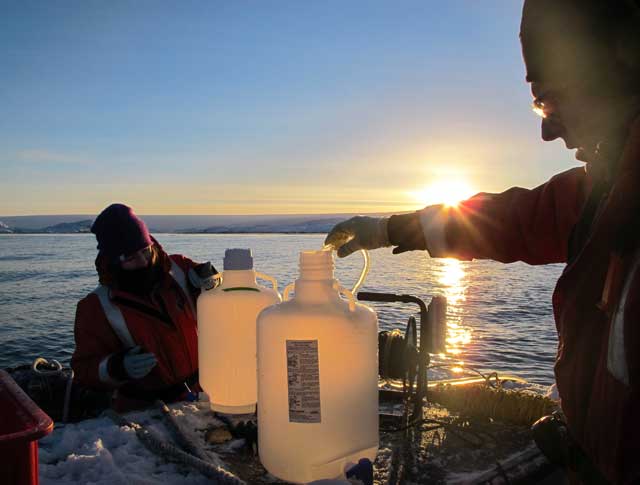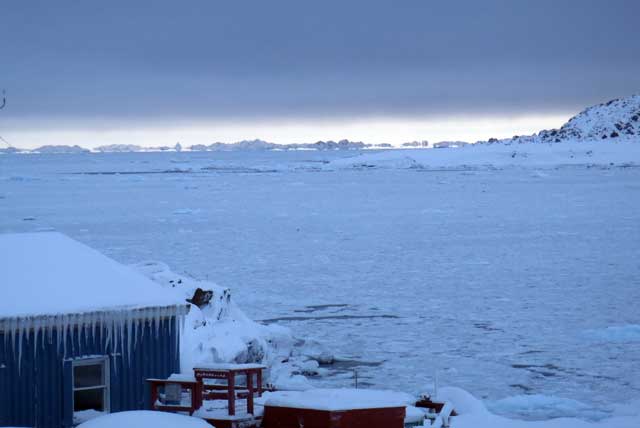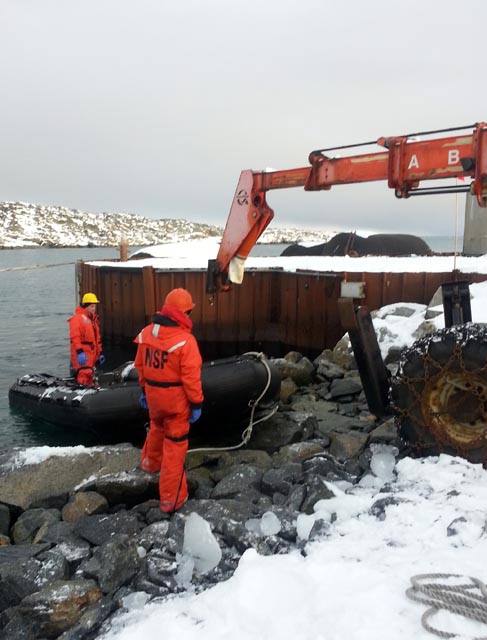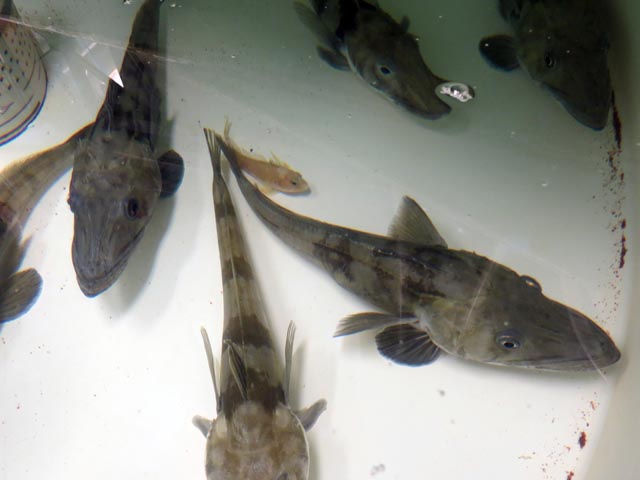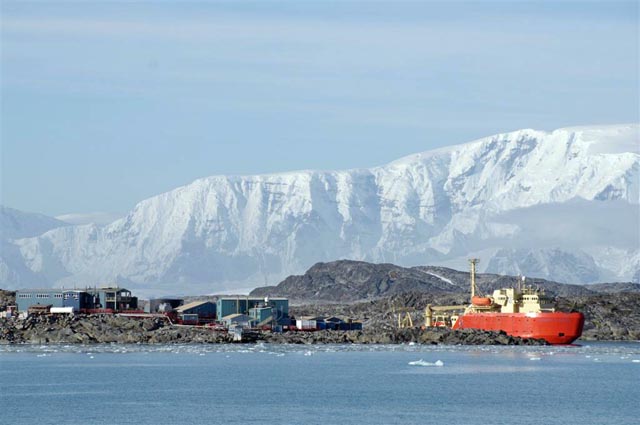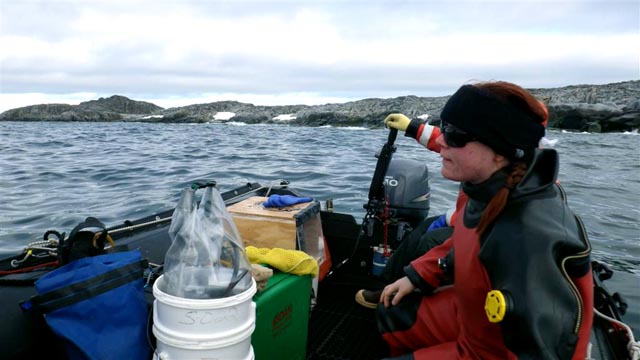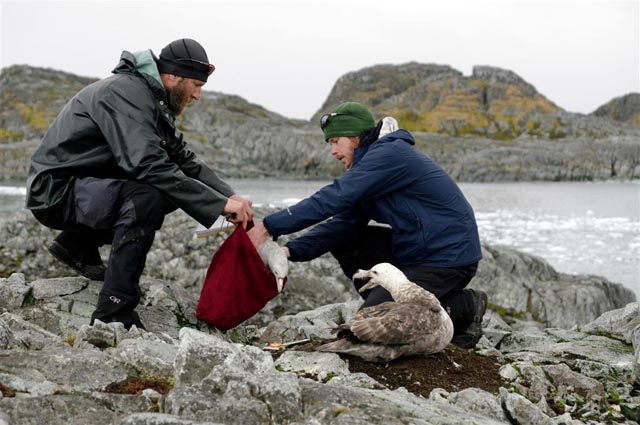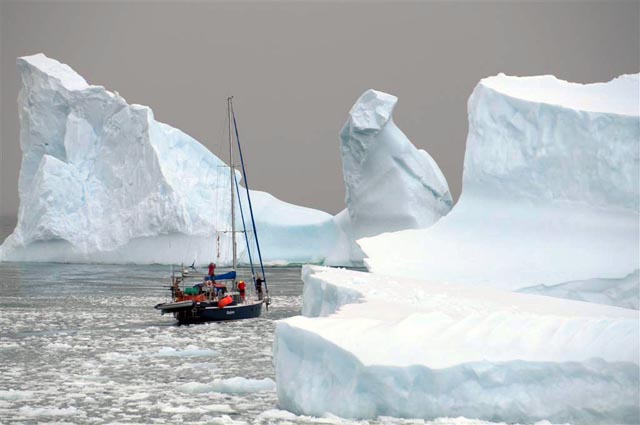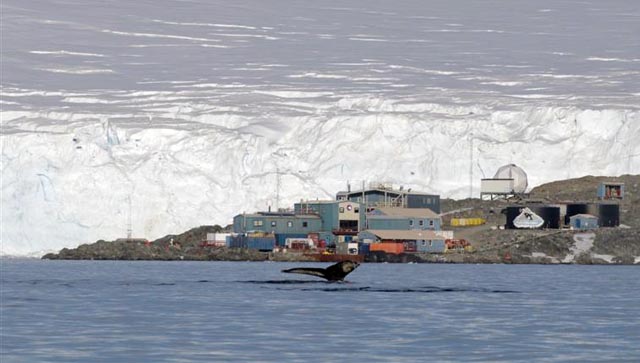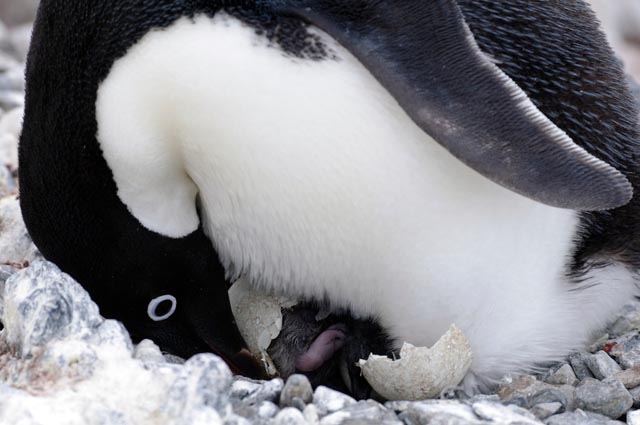|
Palmer Station Archives - 2013 Stiff sea ice around Palmer Station shuts out science, shipsPosted December 13, 2013
The sea ice that was persistent in October continued to surround Palmer Station The research vessel Laurence M. Gould Surgent works with engraving photos onto glass. As part of her process, she has set up numerous homemade pinhole cameras. The pinhole cameras are made from everyday items like soda cans and cardboard boxes. Unlike most cameras, a pinhole camera doesn’t have a lens, but a small hole to let in light. Exposures can take anywhere from a few hours to a few days due to the size of the pinhole. When a camera exposure is set for days, the only movement that is captured would be from the sun or moon if it passes through the frame. The long exposure images Surgent is taking at Palmer could one day become the basis for one of her etched glass works. Comstock is on station to learn about the research projects to incorporate them into her triptych drawings, which are divided into three sections. It is with the drawing that she hopes to explore the perspectives of what people know and see in nature and Antarctica in particular. Her project is called Antarctica: Micro, Macro, and In-between. After dropping off the scientists and artists, the Gould left for what was supposed to be a weeklong research cruise to take core samples from the ocean floor for the ongoing LARISSA The sea ice continued to be a problem for the ship, limiting where it could and couldn’t go to take samples. In fact, the sea ice proved to be a challenge when the Gould attempted to return to Palmer Station. After several days of trying to reach the station, the ship was still about two miles away when the decision was made to head back to Punta Arenas. A handful of people who were looking forward to heading home are now here for an additional seven weeks. [Editor's Note: A tourist ship was able to get close enough in early December to take all five people north.] The wildlife around station became more abundant in November. It has become a common sight to see seals sleeping out on the sea ice. A small pod of Orcas were spotted early one morning just a few hundred yards from station during the brief time when there was open water. Gentoo and Adélie penguins have been making visits to the station, and a leopard seal was observed eating what looked to be the carcass of another seal. Many of the signs of summer in Antarctica have been appearing at Palmer, but it seems that winter still has an icy grip on the station. The impact of sea ice can be felt, from limiting research to preventing cruise ships from visiting. Will the Gould will be able to break through when it finally returns? Stay tuned. Palmer Station reboots science season following partial government shutdownPosted November 8, 2013
October started out pretty rough at Palmer Station At the time the call was made for Palmer to go into caretaker status, the research vessel Laurence M. Gould The mood on station was a somber one, but everyone worked together to ready the station for the quiet months that would be coming. Luckily, the shutdown ended the night before the Gould was set to depart Palmer. Thanks to the small size of the station and understanding of everyone involved, the science season at Palmer was able to restart fairly quickly after everything was unpacked. The only down side for the science groups on station now would be the sea ice. The weather during October was very conducive to the formation of sea ice around Palmer. A large percentage of the research projects conducted around the station, which mainly supports marine-based science, relies on using Zodiac inflatable boats to collect samples from the ocean waters. Thick sea ice makes it impossible to launch a Zodiac and keeps the science groups stuck on station. That means more time in the station’s labs, either calibrating and setting up equipment or even taking water samples from the Palmer seawater intake at the pump house. Two scientists who had wintered over for a project studying Antarctic fish, led by John Postlethwait They were joined by scientists from Rutgers University In addition, on station is principal investigator Gregory Roberts of Scripps Institution of Oceanography The instrument is able to collect a wide variety of information, all in a single integrated package. Some of the instrumentation includes a full weather station, a light sensor, GPS, small particle detection system, and even a device that creates the same conditions that result in the formation of clouds. Work has been started on the relocation of several onsite shipping containers from the pier area to up the hill near Terra Lab. The spaces that will be left vacant from the move will become a new parking area for the Zodiacs and their new trailers. During the winter, construction of a new boating ramp began, with the rest scheduled for installation later this summer. With the new ramp, the Zodiacs can be launched using trailers versus being placed in the water from a Skytrak boom. Once in the water, the boats can be boarded by a new floating dock system rather than climbing over icy rocks. The new boating system should make it much safer for researchers to load and unload equipment and science samples from the boats. It also makes boarding the Zodiacs safer. The Gould will soon be back to Palmer in November, with more research teams to kick the science back into full gear. It is thanks to the amazing staff and flexible scientists that activities at Palmer have been able to go back to normal so quickly, making the government shutdown feel like it was months ago rather than weeks. Now, if the sea ice would just blow away with the winds, it would really feel like the start of summer at Palmer Station. New crew arrives at Palmer Station in SeptemberPosted October 21, 2013
September is a month of transition at Palmer Station The research vessel Laurence M Gould The most dreaded part of the trip is next, the Drake Passage. Due to the shape of the Gould’s hull, in combination with the often rough seas of the Drake, a sort of corkscrew motion is experienced onboard the ship. Meal times tend to be fairly quiet at this point of the trip. After the Drake Passage, the Gould heads down the Antarctic Peninsula, working south to Palmer on Anvers Island. Generally, at this point in the trip, the ship is sailing through sea ice, and the land mass of the peninsula can be seen off the deck. Anticipation rises as the distance to Palmer Station is continually closing. During this last stretch of the trip, sea ice can slow the vessel. However, during this particular trip, high winds kept the Gould from reaching Palmer’s pier. Wind is great for breaking up sea ice, but if it’s too high then it is too dangerous for the Gould to tie up at the station pier. Typically, 35 knots is the safety cutoff. With gusts of more than 70 knots, the ship had to hold off from station until things calmed down. After waiting for a day, exceptional weather made for an uneventful tie-up, followed by cargo offload. During this transition time, two science groups remained on station from the winter. A project led by John Postlethwait A team under principal investigator Linda Amaral Zettler at Marine Biological Laboratory The transition on station is quickly coming to a close. Soon the majority of the summer science groups will arrive, kicking off another busy research season. Until then, the summer crew continues to move forward in preparing the station and themselves for not just the science groups but also for the tourists that will visit on the many cruise ships that frequent the Palmer area. August offers brief respite before summer season beginsPosted September 6, 2013
The month of August was a relatively quiet one at Palmer Station The annual sea ice set up in front of station for a whopping three weeks before strong winds blew it out for good. Most snow accumulation has blown away or simply melted out due to heavy winds and — believe it or not — rainfall during this late winter month. While this has been a mild disappointment for backyard skiers, it has been a bonus for our resident scientists who have been hopeful to collect water samples by boating all winter long. It’s also a bonus for a few recreational boating opportunities to explore around the islands and search for wildlife. It’s been a banner month for wildlife sightings. Highlights include a Weddell seal that has taken up residence in Hero Inlet behind our station; several gentoo and Adélie penguins swimming about; flocks of patrolling snow petrels and giant petrels; an elephant seal puttering around the pier; and a curious flock of some 200 cormorants that have been spotted flying around the vicinity. Meanwhile, our winterover grantees have been moving forward with new experiments in their laboratories. Urjeet Khanwalker and Ashley Nelson, working on a project led by John Postlethwait They’ve also set up a new experiment in which they are growing the embryos at warmer temperatures, around 4 degrees Celsius, instead of the regular ocean temperature of about minus 0.5C. Their hope is to uncover potential effects of warmer waters due to climate change. Scientists Sean O’Neill and Madie Willis have been looking at effects of dissolved organic matter on microbial communities for a project led by Linda Amaral Zettler at Marine Biological Laboratory Research associate Graham Tilbury reports that ultraviolet levels from the sun are increasing significantly this month due to the annual formation of the ozone hole. We’re only just a few weeks away from the arrival of our resupply vessel, the research vessel Laurence M. Gould The beginning of the end to winter season at PalmerPosted August 9, 2013
The month of July began with a delayed departure of the research vessel Laurence M. Gould The research vessel departure was delayed by five days to make more progress on the new boat ramp project. Eight construction workers, three of them divers for underwater work, were scheduled to leave on this vessel. Some of us are hoping that seals will come to enjoy the ramp for naps, but none of them have taken our offer yet. 
Photo Credit: Ryan Wallace
A band of iridescent clouds show up in the afternoon sky near Palmer Station.
There were 22 of us left at the station when the vessel finally departed on July 2. That day the whole station was very quiet. No more sounds of hammer drills at the pier. No more daily false alarms from fire alarm testing. No big ship blocking the view of our beautiful ocean (although we do like everyone on the ship!). The galley was empty with many more chairs than we now needed. A few days later, we had a more intimate mid-winter dinner than was possible in June, with all of us sitting at one table. Our chef prepared a wonderful meal, served by waiters with bow ties. The good food and drink led to a mellow night, with most of us probably crawling into bed early to catch up on sleep to recover from many weeks of activity. This month has been quite windy, with frequent gusts of 60 to 70 miles per hour. The winds and brash ice mostly kept us trapped at the station, as we had only two occasions for boating during the weekends. However, those two outings were blessed with happy sightings of penguins! No one saw any penguins in June, except two Adélies on June 5. On July 7, four of us headed straight to nearby Janus Island, with high hopes that some penguins were still sticking around. We were very excited when we saw eight Adélies porpoising up and down through the surface of the water. We watched them swim to and land on Janus Island. We have seen less and less wildlife lately, but nature still offers us treasures. Earlier this month, we had two days where beautiful bands of iridescent clouds showed up in the southern afternoon sky, opposite from the sun. Speaking of the sun, the daylight is getting noticeably longer, which felt a little weird, since we thought we were just starting the real winter. The temperature has been up and down, sometimes even above freezing, but we had the coldest night of the year so far on July 30 at minus 1 degree Fahrenheit (18 degrees Celsius). One of us still sleeps outside in the tent or the hut when it’s not too windy. Hero Inlet has been partly frozen for a few weeks now, and some of us envy the seals that freely crawl on top of the sea ice. Now much of the water in front of the station is frozen. Four of the winter-overs are scientists. Researchers Ashley Nelson and Urjeet Khanwalkar are continuing the studies of Antarctic fish and their embryos, while Madie Willis and Sean O’Neill are studying microbes in seawater. We are happy that the microbe group regularly heads out to collect seawater samples to keep our boating operation going – at least until the seawater froze. The fish group is observing the development of recently fertilized embryos under the microscope daily. Exciting news is that we saw the first heartbeats in the two-month-old embryos — new life to watch as spring approaches Palmer Station. Wildlife sightings grow less common in dead of winterPosted July 19, 2013
Palmer Station Members from several research groups studying everything for ocean acidification to the odd adaptation of Antarctic fish in the Southern Ocean continued their research during the entire month. Dive operations for a team led by investigators James McClintock and Chuck Amsler 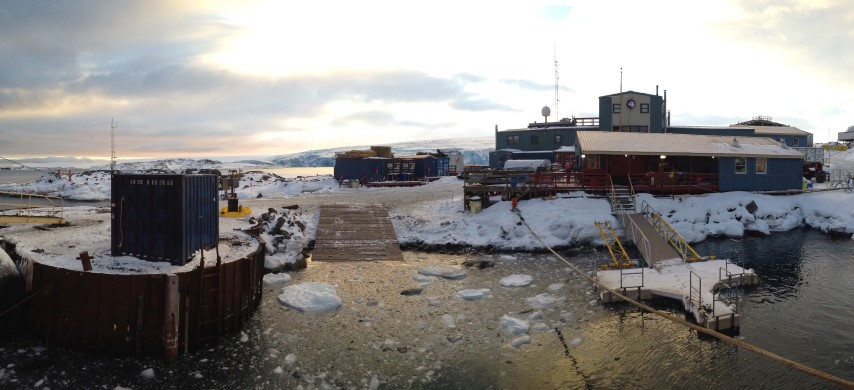
Photo Credit: Bob DeValentino/Antarctic Photo Library
Palmer Station on July 1, 2013, with a new floating pier and boat ramp.
The natural landscape surrounding Palmer Station became quieter, as wildlife populations dwindled to only the occasional sighting. Early in the month, about a dozen fur seals were spotted near the station at Bonaparte Point. Also during the first week of June, a cluster of eight elephant seals was seen huddled in a melted ice depression next to Sheathbill Cove of Amsler Island. There was one report of a leopard seal resting on floating ice near Gamage Point. Crabeater seals were also about. Several species of birds were still present during the month. A flock of more than 100 Antarctic terns were frequently observed swarming around the back of the station and resting along the Arthur Harbor shore. One or two cormorants could be seen perched on snow-covered rocks of local islands, and about a half-dozen were sighted flying by Palmer Station on the first day of June. Other bird species observed during June included Adélie penguins, giant petrels, kelp gulls, snow petrels, and snowy sheathbills. June turned out to be a relatively normal weather month at the station. Apart from a heavy snowfall on the 13th, little snow fell for the rest of the month. Very little sea ice was seen in June. The back of Hero Inlet froze over early in the month, and occasional pancake ice formed there and in Arthur Harbor during the colder days toward the end of the month. A few large ice bergs were seen from the station, but remained well offshore. The glacier fronting Arthur Harbor continued calving intermittently, though at a noticeably slower rate. This article was compiled from the June monthly Palmer Station report by Janice O’Reilly, assistant supervisor of Laboratory Operations, and research associate Graham Tilbury. Construction of boat ramp under way at Palmer StationPosted June 7, 2013
The sound of jackhammers filled the air in May, as construction of Palmer Station’s Scheduled to be completed this year, the new boat ramp will improve safety and make it easier to launch Zodiacs from Palmer. Despite cold weather and short daylight hours, a construction crew is working hard to complete the project before the summer season. In addition to increasing safety, the boat ramp will be capable of launching larger boats as well. In the world of science, Palmer Station’s research season is still going strong. Study of ocean acidification and its effect on sea life is winding down, but expected to start up again in September. Palmer’s two fish groups are busy, as they study cellular regeneration in Antarctic fish and breed them to produce embryos for further research. The arrival of the final re-supply ship for the winter was delayed, as the research vessel Laurence M. Gould Something fishy going on around Palmer StationPosted May 20, 2013
Winter has come to Palmer Station Braving the rough seas of the Southern Ocean, the first group to arrive hails from the University of Oregon Postlethwait’s team is studying the genetic and phenotypic difference between those Notothenioidei that have lightweight skeletons, such as the blackfin icefish (Chaenocephalus aceratus) and those that have normal skeletal structure yellowbelly rock cod (Notothenia coriiceps). The goal of this study is to find those genetic pathways the may be related to bone loss due to aging in humans. [See previous article — Raising Notothenioidei: Scientists successfully develop icefish embryos for evolutionary studies.] The second group to arrive is headed by Kristin O'Brien 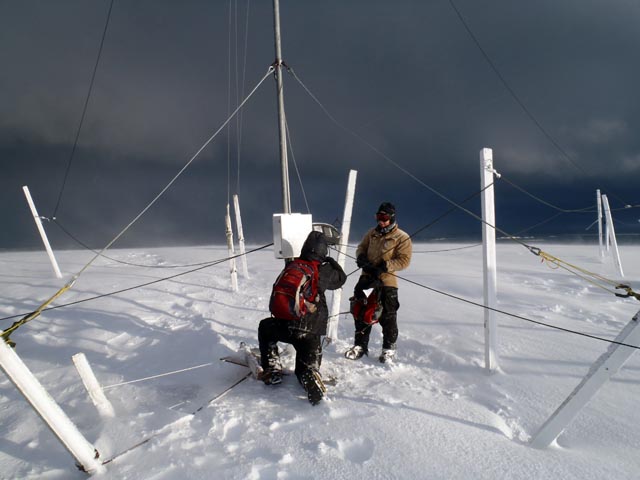
Photo Credit: Yuki Takahashi
Scientists work on a very low frequency antenna for observing lightning and related phenomena.
The goal of this study is to determine whether those Antarctic icefish that lack hemoglobin enjoy an advantage in comparison to red-blooded fish in the frigid waters around Antarctica. In addition to the new science groups that have arrived this season, Palmer continues to support the ongoing research into ocean acidification and its effects on native Antarctic organisms. Headed by long-time science mainstays, Chuck Amsler and James McClintock Palmer also played host to two short-term science projects: One study involved permafrost, which covers a number of islands near Palmer Station, and the amount of loss caused by climatic warming trends. The other research looked at lightning in the ionosphere and other electrical phenomenon that can be observed with low-frequency antennas. Despite the cold weather, and shortening daylight hours, there is no stopping the research taking place on the Antarctic Peninsula and Palmer Station Palmer Station prepped and ready for winter seasonPosted April 12, 2013
The biggest change at Palmer Station The fish are scientific specimens for a study looking at bone loss and osteoporosis. Some fish in the Southern Ocean have evolved with almost no red blood cells and lightweight skeletons that mimic the disease known as osteoporosis. Scientists hope to isolate the genes that helped these icefish adapt to the cold Antarctica waters differently than other closely related fish. Research may eventually help with treatments for bone loss in humans. Bill Detrich from Northeastern University In addition to crew turnover, the first steps in building the Palmer boat ramp began in March. Earlier this year, a floating dock was built. [See previous article — Docked: New pier built at Palmer Station for small boat operations.] The next phase of the project to make small-boating operations safer at Palmer involves installing a ramp over the coming months. The area leading to the shoreline needs to be leveled out as part of the preparations for the boat ramp installation. While some of the rocks can be moved around with the loader bucket, others need to be smashed with power hammers and broken up into much smaller pieces. This work is being done concurrently with the normal boating operations by researchers, so great care and coordination between the construction crew and the science teams on station are needed to be sure that they can all take care of the work that needs to be done. Part of the preparations to get the station ready for winter took place on the glacier behind Palmer Station. Personnel ensured the boundary flag line was well marked on the glacier, which is a popular place for hiking and skiing, as well as glacier rescue training. Due to the rapid retreat and melting of the glacier, new crevasses form fairly quickly and the flag holes melt out, making safe travel harder to identify. In addition to making travel tricky, melting has also been causing problems with the radio repeater and VLF antenna on the top of the glacier. Several trips were made to drill new holes to improve the stability of both the VLF and radio antenna. In addition to fishing expeditions, the Gould made a side trip to the nearby Ukrainian station Vernadsky The summer crew will find themselves sailing north shortly, with the station in the capable hands of the new winter crew. Signs of winter approaching at Palmer StationPosted March 8, 2013
As February came to a close at Palmer Station The research vessel Laurence M. Gould However, a few research teams still remain, and we welcomed a new group to the station in mid-February with a long history in the U.S. Antarctic Program Amsler Island is located just across Arthur Harbor from Palmer Station. It is home to what is now referred to as Old Palmer. It was at Old Palmer where U.S. Navy personnel lived while constructing the current station. While on station, the team will continue its research on ocean acidification. [See previous article — Perfect storm: Add ocean acidification to the list of threats faced by the Antarctic Peninsula.] The whale research team led by Duke University The vast majority of Adélies and other penguin species have left the Palmer area. There are no more penguins viewable on the Torgersen Island penguin webcam In early February, a helicopter based off of the Chilean naval ship Aquiles visited Palmer Station. On board the helicopter was a scientist who was collecting samples of the grasses that grow in the Palmer area. A second visit by the Chileans later in February involved not a helicopter but a fly-by from an airplane. Palmer also hosted the last of the scheduled cruise ships for the season, along with several yachts. Not all visits to Palmer are by cruise ship; private or chartered yachts also occasionally visit the station. One such yacht was the S/Y Quijote, a 40-foot, steel-hulled boat hand-built by the captain. Two ships support Palmer LTER program in JanuaryPosted February 15, 2013
January at Palmer Station During the annual LTER cruise, the Gould spends a month following nearly the same grid pattern in the ocean that was set up in the fall of 1990 when the program was established. The ability to sample the same places for the past 23 years — though the study area was expanded farther south several years ago — means the data scientists collect can offer insights into the long-term environmental trends under way in the area. Oceanographic, atmospheric and sea ice data give researchers an idea of the impact of the sea ice coverage on the overall ecosystem. On the biological side, researchers study top predators like penguins and seals, along with the rest of the polar food web, from shrimp-like krill to the bacteria in the ocean. While the ship is out during the LTER cruise, there is still a lot of fieldwork near the station around Anvers Island. Some samples are collected in conjunction with the LTER cruise to contrast the regional changes against a more concentrated area. The Gould wasn’t the only research vessel (R/V) at Palmer supporting science in January. Near the end of the month, the R/V Point Sur The group, under a project led by David Barbeau Because they were unable to put in at any of the field locations, the team ended up having to set up tents at Palmer Station until the end of the LTER cruise because the station had reached its maximum population of 44. The Point Sur will also support scientists led by a team from Duke University January has also been a busy month for visitors. We had visits from both the Chilean and British navies. A number of tourist cruise ships also came and went. The cruise ships that visit Palmer range from small yachts to large 1,300-passenger ships. The number of passengers dictates how we handle a visit. If there are more than 200 aboard, then station personnel go out to visit the ship and give a presentation about the science that the U.S. Antarctic Program Wildlife was fairly active in January. There are several sheathbill nests on station with chicks that hatched. The Adélie penguin chicks have grown to about the size of the adults, and they are in the process of losing their soft, downy feathers. [Check out the penguin cam at Torgersen Island The summer science season still has a few more months left before winter starts. But the coming colder, dark months promise to be as busy as a typical summer season. Palmer Station hosts visitors large and small in DecemberPosted January 4, 2013
December was full of visitors at Palmer Station The month started off with a short, two-day visit from the Gould. Aboard the ship was a team that heads the company charged with running the logistics contract for the National Science Foundation (NSF) Parazynski is a former NASA Shortly after the departure of the Gould, Palmer had its first cruise ship visit with the National Geographic Explorer. There are only a limited number of such tourist ships that can visit the research station each year. In order to visit, the ship needs to put a request in through the NSF. This keeps station services from being constantly interrupted by a continued stream of visitors. Cruise ships with less than 200 passengers are able to visit Palmer directly. Station personnel guide the visitors on a walking tour, talking about everything from how fresh water is made to the research under way and recreational opportunities. And, of course, we talk up the famous Palmer brownies that wait in the station dining hall (referred to as the galley), which is turned into a temporary visitor center where guests can interact with station science and support personnel. If a cruise ship has more than 200 passengers aboard, Palmer personnel will visit the vessel via Zodiac. The passengers are treated to a presentation about the station activities, along with a meet and greet with the station staff and scientists. The only other cruise ship to visit Palmer during December was the Le Boreal. This is part of a special yearly visit when the guests on the cruise donate a gift to the scientists of the Palmer Long Term Ecological Research (LTER) The gift this year was for a Penguin-Cam that will be installed on Torgersen Island. Once the camera is set up, people from around the world will be able to view the Adélie penguin population online. The camera will also allow for scientists to give talks in real-time with classrooms back in the United States and other locations worldwide. There was also a visit from the ice patrol ship the HMS Protector, formerly the MV Polarbjorn. The visit from the Protector was not just a friendly visit but also an official one. A group from the ship came to station to perform an official Antarctic Treaty Shortly after the Protector departed station, a ship from the Chilean navy paid an informal, friendly visit. About 30 crewmen came ashore for a tour of the station. The crew left us several gifts, including a book about the Chilean navy, an updated picture of their ship, and several other items from their homeland. December was also a big month for wildlife. The Adélie eggs on Torgersen have started to hatch, filling the air with chirps from the little chicks. The krill in the waters near Palmer have just exploded, feasting on the phytoplankton blooms. The abundance of krill has drawn many whales to feed in the area. So far, we have spotted mostly humpback and minke whales. On Christmas day, many of us had an opportunity to observe a pair of humpbacks feeding around Bonaparte Point. The next day, possibly the same two whales were seen feeding just off of the seawater intake pump house, right next to the station. The holiday celebrations at Palmer were fairly laid back, with a gift exchange and a family style meal. Most people took advantage of the down time to call home and talk to family and friends. It was a quiet and reserved end to a fairly busy month, but it is looking like January will be an even busier month. |
Home /
Around the Continent /
Palmer Station Archives - 2013
"News about the USAP, the Ice, and the People"



For USAP Participants |
For The Public |
For Researchers and EducatorsContact UsU.S. National Science FoundationOffice of Polar Programs Geosciences Directorate 2415 Eisenhower Avenue, Suite W7100 Alexandria, VA 22314 Sign up for the NSF Office of Polar Programs newsletter and events. Feedback Form |



